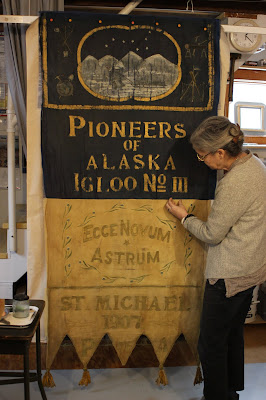The Pioneers of Alaska
is a fraternal organization originally founded in Nome, Alaska, in 1907 to
preserve the legacies of all the state's early white settlers, collecting
material related to Alaska's history, and promoting "the best interests"
of the state. The organization also provides mutual aid, which was a critical
safety net in territorial days and early statehood when there was a lack of
reliable public or government services. Alaska was home to several similar
organizations, but now only the Pioneers remain.
The Pioneers of Alaska was, and still is, an organization formed from the need of helping each other survive. Helping by providing food, care, medical, legal assistance, recreational opportunities, and social interaction was vital for life in this new and sometimes extremely harsh environment. Conditions of life in this rugged frontier made mutual associations necessary. This northern spirit lives on and is the base for the Pioneers of Alaska.[1]
Originally restricted to
white males who entered Alaska before 1900, the organization's membership today
must be residents of Alaska for at least 20 years to be eligible to join. Once
led by men, women became eligible for all leadership positions in 2012. The
Pioneers are divided into 16 igloos, or chapters, each for men and women. The
Grand Igloo unites Alaska’s Pioneers by meeting once each year with the
subordinate Igloos which take turns hosting these conventions. The subordinate
igloos maintain active schedules of business meetings and social gatherings.
The Pioneers, long involved in legislating fish and game laws and garnering
support for the elderly, also played a key role in bringing Alaska into
statehood.
The painted fabric
banner receiving treatment in the Conservator's Studio was one created for
Igloo III, located in St. Michael, a small community near Nome. The St. Michael
Igloo was chartered on May 10, 1907. Today, St. Michael's population is less than
500 residents.
 |
| Historic image of the hall interior with the banner at the back wall. |
Tears in the fabric,
paint loss, and a missing tassel were attended to by conservator Gwen Spicer.
The recent banner from
the pioneers treated was an unusually constructed vernacular design with four
satin weave fabric panels, two dark blue, and two white. These panels were
positioned with the selvage edges horizontal, allowing for the stronger weft threads
to carry the weight, but also creating vertical tears.
 |
| In addition to a painted scene featuring a man pulling a sled at the top, lettering at the bottom spells out the Pioneers' motto, Ecce Novum Astrum, "Behold the New Star." |
The reverse side of the banner, a cotton layer, shows extensive water damage.
The layers of the banner
were separated to gain access to the reverse sides of the fabric. This also
allowed for each side to be cleaned. Then the loose threads were aligned and
supported with a full adhesive backing. By having the banner and its layers
hanging vertically, the best alignment of the layers could be ensured.
Gwen stitches the banner to a new fabric backing
The banner above is not
the first banner of this type to be treated in our studio. Previously a banner
a more traditionally made banner from 1909 for the Fairbanks Igloo was treated.
 |
| Before treatment of both the front and reverse sides of the Fairbanks Igloo #4 Banner |
 |
| Detail of an earlier Pioneer banner from Igloo 4 |
 |
| After Treatment of the Fairbanks Igloo #4 Banner |
Notes
[1] Pioneers of Alaska website. http://www.pioneersofalaska.org/igloo_history.html. Accessed April 10, 2020.
Resources
"Behold the New Stars: Pioneers Crown New Royalty." https://www.juneauempire.com/news/behold-the-new-stars-pioneers-crown-new-royalty/. May 14, 2018. Accessed April 10, 2020.



No comments:
Post a Comment